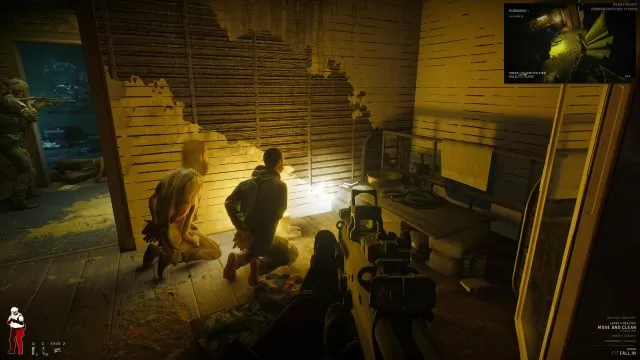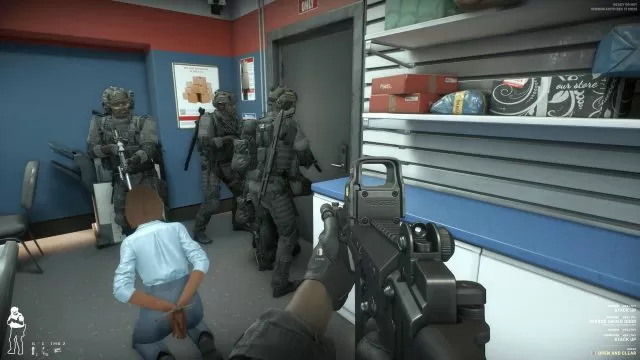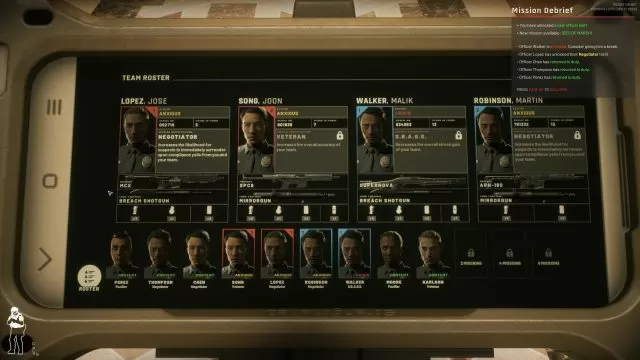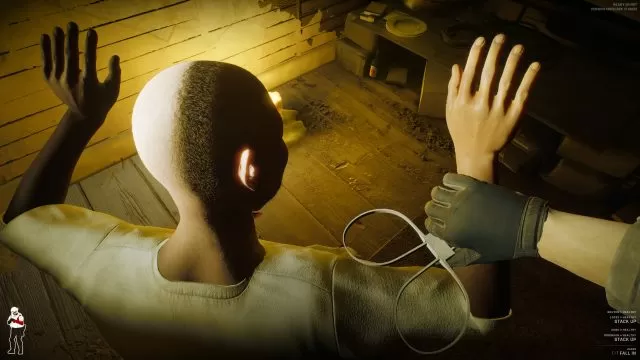Ready or Not Review – “Controversial”
Games glorifying banditry are legion, but only a few lionize law enforcement. Taking a conscious risk of sounding like an average grandfather, I’ll label that disproportion troubling. Even more worrying is the rotten attitude of the mainstream gaming press concerning the singular significant pro-law game in recent memory. Ready or Not, the true spiritual and conceptual successor to S.W.A.T. 4 (2005), was stigmatized as problematic and controversial ever since it launched in early access. Expertly simulating the armed response against meth dealers, terrorists, gun runners, violent pedophiles, and school shooters drew the inexplicable ire from some journos. The backlash and the “f*ck the police” attitude are super puzzling. Maybe it’s the American thing, and I, being European, just can’t grasp the “controversy”?
Swatted but in a good way

Let’s not dwell on that any longer. Ready or Not simulates S.W.A.T. operations in Los Sueños, USA. This faux Los Angeles carries the same burden as its real counterpart, being the hotbed of every depravity known to man. As a S.W.A.T. team leader, you’ll command your tactical element in the field, dealing with armed opposition and civilians, trying to do things by the book. That means following the procedures to the letter, especially the ones regarding the well-being of civilians and surrendered perps. There’s a lot of killing in this game, but every lethal outcome here is a consequence of non-compliance. If you are armed and refuse to hit the dirt when instructed, the lead poisoning is on you, mate.
Ready or Not has a loose-tied campaign consisting of eighteen missions. There’s no unifying narrative, but some missions share the continuity, creating disjointed mini-stories. Contrary to modern trends, this game doesn’t tiptoe around difficult issues. Instead, it chooses to hit the nerve, re-enacting a few painful episodes that dominated the news cycles in the last decade. Among others, Ready or Not deals with school shootings, terrorist nightclub raids, rural militias, and even high-end pedophile rings. The game unapologetically throws you into the series of contemporary clusterf*cks, providing you with the tools and the means to bring order to chaos.
Procedures save lives

The key to success in each mission is synergy between equipment, operators, and orders. Every piece of gear, save the unlockable cosmetics, is available from the start. You have complete freedom in equipping your people with whatever weapons and gadgets you see fit, but some choices make more sense than others. Having one member with a ballistic shield will reduce the risk of team casualties during breaching, for example. The same goes for having night-vision goggles for night ops, or when assaulting people smugglers’ tunnel network. Using the mirror gun for pre-breaching recon also doesn’t hurt. Giving high-caliber assault rifles to every team member might sound like a good idea until the first friendly fire incident. Yes, the bullet-proof vest didn’t help the perp, but the high penetration rounds also killed the hostage cowering beneath the furniture.
Your tactical section consists of two pairs, each operating as an autonomous sub-unit. You can order blue and red pairs separately, which is useful for simultaneous breaches through two different doors and similar situations. For the most part, however, you’ll direct your people as one unit. Constant caution is necessary, even if it means repeating the procedure ad nauseam. A case in point is sliding the mirror gun under the door you’re about to breach; if there’s armed opposition on the other side of a locked door, it might be pertinent to order a shotgun breach followed by flashbang instead of picking the lock and just strolling inside. You’ll issue all those orders through a well-designed and intuitive contextual menu.
Expendables

Paradoxically, individual people aren’t as important, unless you decide to chase the Steam achievements. Every team member has a potential skill, unlocked after several successful missions. During those excursions, however, members accumulate stress. If unchecked, tension can lead to crisis and people resigning from the unit. but if you rotate personnel and assign the people on edge to the therapist, you’ll be fine. Or you can choose to ignore all that and simply hire new guys after old ones quit or die.
But what about those skills? Some of them, such as “intimidator” which increases the chance of perps complying with orders, are nice to have but not essential. Having a green team might lead to extra casualties, but as long as you manage to complete the primary assignments, you’ll move on with the campaign. You can easily lose hundreds of operators, firing and hiring new ones constantly and without penalties. The campaign doesn’t have a classic difficulty curve, so you don’t need to “save” the best people for the finale. More consequential human resources management would greatly contribute to realism in both logistical and emotional sense. You can, in theory, get attached to your people here, but only if you decide to push for Ironman-related achievements.
So, are you ready or not?

Kicking the door down and ordering everyone to freeze or hit the dirt, is there a more exciting and fulfilling aspect of crime fighting? There are precious few games of this type, and S.W.A.T. 4 was probably the last great one. But now, after almost two decades, Ready or Not is here to upset the status quo. This gorgeous-looking title offers both procedural and tactical realism while being exciting as hell at the same time. If you are even remotely interested in the SWAT methods and ops, you should give it a whirl without hesitation.
Highs
- Great variety of missions inspired by contemporary events.
- Slick, intuitive command interface.
- Realistic tactical procedures, weapons, and equipment.
Lows
- Passive opponents that rarely show initiative.
- Lackluster human resource management.
- Inadequate tutorial for such complex game.

